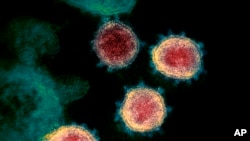Colorado’s flagship university is getting a head start spotting COVID-19 outbreaks among students at residential dorms -- by testing the wastewater.
Cresten Mansfeldt, an engineering professor at University of Colorado-Boulder, heads out with students to start an early warning system on the campus for SARS COV-2 -- the virus that causes COVID-19. The warning system involves a plastic bin and what can be found below a sewage manhole.
As for the project’s name...
“Well, we call our project ‘Project Half-Shell,’ because it's an homage to the Teenage Mutant Ninja Turtles,” Mansfeldt says. “Hanging out in the sewers.”
Mansfeldt’s team all wear masks to guard against COVID-19. Plus, they’re dressed for dirty work, in overalls and work gloves. There’s some heavy lifting up ahead, too. That manhole cover weighs over 100 kilograms. Mansfeldt lifts the lid then points a flashlight into the hole. Ten feet underground, a concrete ditch carries a glistening stream of sewage water.
'Domestic wastewater'
"So, what's flowing through here is actually domestic wastewater,” Mansfeldt says. “Things we send down the drain either through the toilets or through showers or laundry systems. Basically, any drains that are coming out, end up flowing into these river networks that exist underneath most municipalities and cities.”
“Here,” he said, “we're most interested in what's coming out of the toilets. In feces, because that seems to be where individuals can shed the SARS COV-2 virus here.”
Engineering student Jessica Darby says checking wastewater this way gives an early warning about COVID-19 infections.
“COVID is in your intestines,” she says. “And so even if you don't have symptoms, or before it actually is more of a disease or infection, it can be found in your intestines. So if you shed it into the sewer system, you can kind of determine if people have it, even if it's before they have symptoms, or if they don't ever have symptoms.”
To test this dorm’s wastewater for COVID-19, Mansfeldt’s team unlocks a large plastic bin that’s beside the manhole. Inside is a 2-liter jerry can and some very long tubes. The team snakes the tubes down until they touch the sewage water. Back inside the plastic tub, they switch on a little pump.
Once each day, the Project Half-Shell team will unlock the tub and take a few vials of wastewater over to the lab, to screen an entire dorm for COVID-19.
An early warning
Mansfeldt says that testing wastewater this way saves on testing time and testing supplies.
“A single sample here is reflective of hundreds of people's contribution,” he says.
Earlier this fall, data from the team warned the campus about a rising spike in COVID-19 cases. Individual saliva tests of dorm residents then identified who was sick, and it was quite a few.
“This led the administration to actually invoke some of the social-distancing options that were available,” Mansfeldt says.
Two weeks later, data showed the restrictions could be relaxed.
Wastewater testing can also provide an early warning in countries that have cholera and polio. As for COVID cases in the U.S., Mansfeldt says that in addition to screening college dorms, some communities are also screening sewers for early signs of SARS-COV2 outbreaks at nursing homes and schools.








